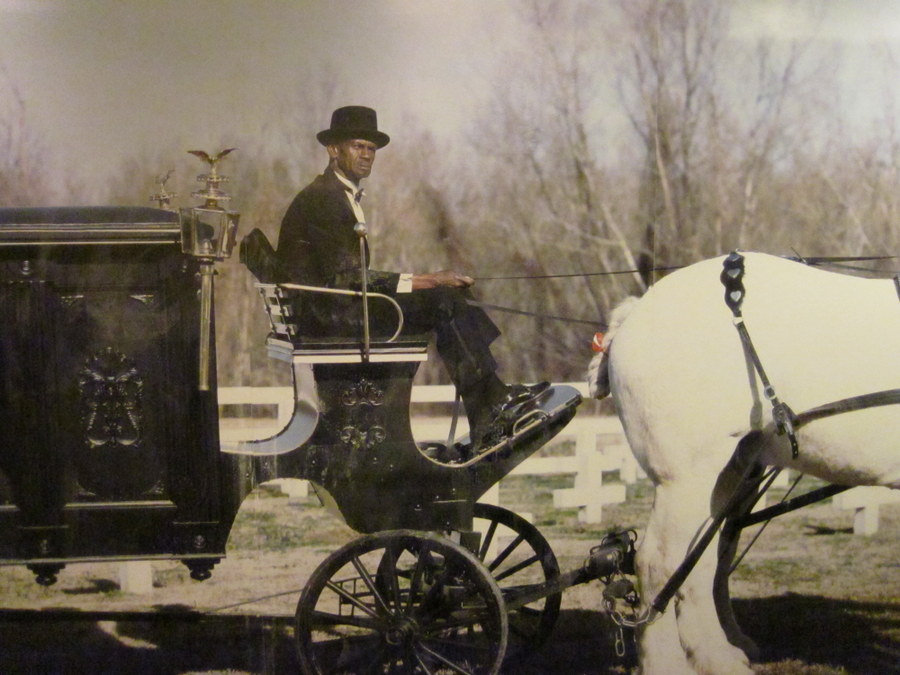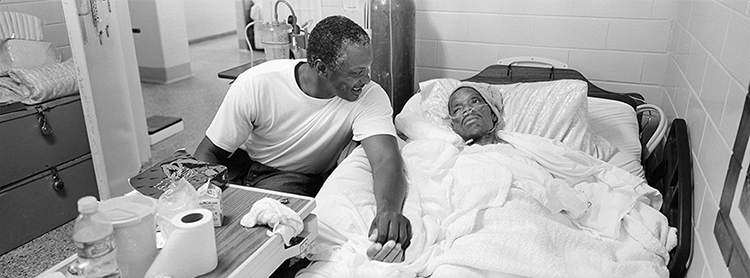
The first shock is that just outside the gates of the Louisiana State Penitentiary at Angola, a former slave plantation that into the 1960s was known as the “bloodiest prison in the south,” there is a museum for tourists.
The second shock is that inside the museum, past the awkward diorama of taxidermal wildlife—wolf, raccoon, alligator, and the rare Angola blue crawfish, all shot and killed on prison grounds—, past the old electric chair, and exhibits on homemade prison weapons, women prisoners and paraphernalia used in escape attempts, is an exhibit on death and dying at Angola. Here, unlike most other prisons on earth, terminally ill inmates receive hospice care. And it is given not by professional nurses or hospice workers, but other inmates.
“Hospice caregivers are a special group of prisoners who volunteer and are trained to take care of their dying brothers, knowing full well that they also, maybe in that Hospice bed themselves one day,” reads a museum placard. “Surprisingly, large and burly, convicted violent offenders turn tender and compassionate taking care of the men in the Hospice beds.”
__________________________________________________
Angola, featured in films such as The Farm: Angola, USA and Dead Man Walking has the highest percentage of prisoners serving life sentences of any prison in the United States. According to a 2002 article in the Journal of Palliative Medicine, about 85 percent of 5108 inmates incarcerated at that time were serving life sentences and expected to die at the prison.
Behind Angola’s graying populace is the state of Louisiana’s penchant for incarceration.
“Sentences of several decades, or even life, for nonviolent crimes are not unusual in Louisiana,” wrote investigative reporter Cindy Chang, in a 2012 New Orleans Times-Picayune article. “Unusually tough sentencing laws are one major reason Louisiana has the highest incarceration rate in the world.”
A recent article in the magazine Mother Jones talks about a Shreveport, Louisiana man serving a life sentence at Angola for dealing with an undercover cop, “two crumpled bags of marijuana, worth $10 each.” According to the American Civil Liberties Union, nationwide, at least 69 people are serving life sentences for pot.
Expectedly, being tough on crime is a point of pride among prosecutors and police chiefs, but in Louisiana, the stance has become something of a sociopathic sickness. We need to “kill more people,” Dale Cox, District Attorney in Caddo Parish, in western Louisiana, explained to several different awestruck reporters earlier this year—between 2010 and 2014, Caddo Parish sentenced more people to death per capita than any other county in the United States.
In his 2003 book, Aging Prisoners: Crisis in American Corrections, Ronald Aday, a sociologist at Middle Tennessee State University, lists several reasons why so many elderly Americans are ending up in prison these days: The shift toward mandatory minimum sentencing, the war on drugs, the violent nature of late-life offenders, and the graying of America in general.
“As we transition into the 21st century, we find ourselves exploring a new frontier, with the elderly serving as pioneers in our health-care system, churches, families, and prisons,” says Aday. “A decade or so ago, we would never have thought it possible that prison nursing homes would become a necessity.”
Prisoners, according to a recent New York Times article, live on average 15 years shorter than people out in the free world. HIV, hepatitis C, limited education, hypertension, diabetes, smoking, drug abuse, dementia, depression, and head injuries from fights and other violence all help to swerve many inmates toward an early death.
At Angola, inmates are put to work: farming crops, making license plates, cleaning dorms, and much more. Not only do inmates also serve as hospice workers, inmates who die at Angola are given a funeral service inside a 6,000 square-foot Catholic chapel called Our Lady of Guadalupe, informally dubbed “The Alamo”, and built by inmates in 2013. After services, inmates build a funeral procession in an ornate horse-drawn hearse. Burial is in simple wooden coffins crafted by inmates and takes place at one of two cemeteries on Angola grounds, in graves dug by inmates.
While care and compassion at the end of life might seem like a God-given right for all human beings, even those who are prisoners, the Angola exhibit reveals that there are only 14 prisons in the country with hospice programs.
In May 2000, Angola received the Circle of Life Award, which was granted by the American Hospital Association and came with a check of $25,000 in recognition of the prison’s hospice program. The funds are intended to improve and continue the program.

The hospice volunteers must go through a difficult process to bury their own regrets and fears, and unearth their capacity to love. Grace Before Dying looks at how, through hospice, inmates assert and affirm their humanity in an environment designed to isolate and punish. (Photo Source: gracebeforedying.org)
What does being an Angola prison hospice volunteer entail?
Inmates visit their terminally ill comrades several times a week, and when the time of death comes, they sit vigil for the last days.
“Certainly there are better volunteer jobs at Angola than changing an adult man’s diapers,” reads the exhibit. “Why do these men do this work?”
Randolph Matthieu, an Angola inmate who has worked as a hospice volunteer for 11 years, explains that he is led to helping his fellow inmates in this way because “I could be in the bed myself.”
“I don’t know which one will get me first,” a 59-year-old inmate who had recently been diagnosed as being HIV positive, and also having hepatitis C and an aneurysm, says in one newspaper article posted in the exhibit. “You know we’re all terminal. I just thank God that I’m aware of my time and that I have been called to repentance. Next to being free, this is the best place for me to be. You know I seldom think about being terminally ill. My spirits are pretty good.”
In a video about the hospice program shown in the museum’s small theater, hospice volunteer Anthony Diggs says that being a volunteer, “opened my heart up as well as helped them to comfort their hearts and their souls.”
Another volunteer says that his mother never forgave him for his crime and imprisonment. But when he became a hospice volunteer and began helping others calmly and comfortably make their way through the doorway of death, his mother once again became proud of him. Not long afterward she too passed away.
At one point in the video, a terminally ill patient grimly reveals what happened to old and dying patients before the hospice program was initiated: Inmates were put in a room and left alone to die.
The hospice program seems to ensure that such treatment will never happen again, at least at Angola.
“They come to love you,” one volunteer in the video explains of his patients, “and you love them, it’s unavoidable.”
The Angola Museum is open Monday to Friday 8-4:30, Saturday 8-4, Sunday 12-4. Visit the museum online here: http://www.angolamuseum.org
Follow Digital Dying on Facebook, and author Justin Nobel on Twitter

“All of these animals were found at Angola, and killed at Angola,” explains Angola Museum director Marsha Lindsey.









